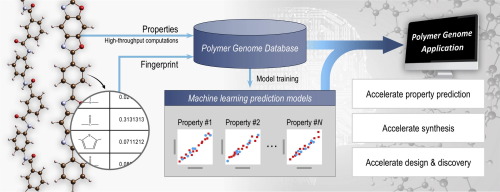当前位置:
X-MOL 学术
›
Mater. Today
›
论文详情
Our official English website, www.x-mol.net, welcomes your
feedback! (Note: you will need to create a separate account there.)
Scoping the polymer genome: A roadmap for rational polymer dielectrics design and beyond
Materials Today ( IF 21.1 ) Pub Date : 2018-09-01 , DOI: 10.1016/j.mattod.2017.11.021 Arun Mannodi-Kanakkithodi , Anand Chandrasekaran , Chiho Kim , Tran Doan Huan , Ghanshyam Pilania , Venkatesh Botu , Rampi Ramprasad
Materials Today ( IF 21.1 ) Pub Date : 2018-09-01 , DOI: 10.1016/j.mattod.2017.11.021 Arun Mannodi-Kanakkithodi , Anand Chandrasekaran , Chiho Kim , Tran Doan Huan , Ghanshyam Pilania , Venkatesh Botu , Rampi Ramprasad

|
Abstract The Materials Genome Initiative (MGI) has heralded a sea change in the philosophy of materials design. In an increasing number of applications, the successful deployment of novel materials has benefited from the use of computational methodologies, data descriptors, and machine learning. Polymers have long suffered from a lack of data on electronic, mechanical, and dielectric properties across large chemical spaces, causing a stagnation in the set of suitable candidates for various applications. Extensive efforts over the last few years have seen the fruitful application of MGI principles toward the accelerated discovery of attractive polymer dielectrics for capacitive energy storage. Here, we review these efforts, highlighting the importance of computational data generation and screening, targeted synthesis and characterization, polymer fingerprinting and machine-learning prediction models, and the creation of an online knowledgebase to guide ongoing and future polymer discovery and design. We lay special emphasis on the fingerprinting of polymers in terms of their genome or constituent atomic and molecular fragments, an idea that pays homage to the pioneers of the human genome project who identified the basic building blocks of the human DNA. By scoping the polymer genome, we present an essential roadmap for the design of polymer dielectrics, and provide future perspectives and directions for expansions to other polymer subclasses and properties.
中文翻译:

聚合物基因组的范围界定:合理的聚合物电介质设计及超越路线图
摘要 材料基因组计划 (MGI) 预示着材料设计哲学的巨变。在越来越多的应用中,新材料的成功部署得益于计算方法、数据描述符和机器学习的使用。聚合物长期以来一直缺乏大化学空间的电子、机械和介电特性数据,导致各种应用的合适候选者停滞不前。过去几年的广泛努力已经见证了 MGI 原理在加速发现用于电容储能的有吸引力的聚合物电介质方面的卓有成效的应用。在这里,我们回顾了这些努力,强调了计算数据生成和筛选、靶向合成和表征的重要性,聚合物指纹识别和机器学习预测模型,以及创建在线知识库以指导正在进行和未来的聚合物发现和设计。我们特别强调聚合物在基因组或组成原子和分子片段方面的指纹识别,这一想法向人类基因组项目的先驱致敬,他们确定了人类 DNA 的基本构建块。通过对聚合物基因组进行范围界定,我们提出了聚合物电介质设计的基本路线图,并为扩展到其他聚合物子类和特性提供了未来的前景和方向。我们特别强调聚合物在基因组或组成原子和分子片段方面的指纹识别,这一想法向人类基因组项目的先驱致敬,他们确定了人类 DNA 的基本构建块。通过对聚合物基因组进行范围界定,我们提出了聚合物电介质设计的基本路线图,并为扩展到其他聚合物子类和特性提供了未来的前景和方向。我们特别强调聚合物在基因组或组成原子和分子片段方面的指纹识别,这一想法向人类基因组项目的先驱致敬,他们确定了人类 DNA 的基本构建块。通过对聚合物基因组进行范围界定,我们提出了聚合物电介质设计的基本路线图,并为扩展到其他聚合物子类和特性提供了未来的前景和方向。
更新日期:2018-09-01
中文翻译:

聚合物基因组的范围界定:合理的聚合物电介质设计及超越路线图
摘要 材料基因组计划 (MGI) 预示着材料设计哲学的巨变。在越来越多的应用中,新材料的成功部署得益于计算方法、数据描述符和机器学习的使用。聚合物长期以来一直缺乏大化学空间的电子、机械和介电特性数据,导致各种应用的合适候选者停滞不前。过去几年的广泛努力已经见证了 MGI 原理在加速发现用于电容储能的有吸引力的聚合物电介质方面的卓有成效的应用。在这里,我们回顾了这些努力,强调了计算数据生成和筛选、靶向合成和表征的重要性,聚合物指纹识别和机器学习预测模型,以及创建在线知识库以指导正在进行和未来的聚合物发现和设计。我们特别强调聚合物在基因组或组成原子和分子片段方面的指纹识别,这一想法向人类基因组项目的先驱致敬,他们确定了人类 DNA 的基本构建块。通过对聚合物基因组进行范围界定,我们提出了聚合物电介质设计的基本路线图,并为扩展到其他聚合物子类和特性提供了未来的前景和方向。我们特别强调聚合物在基因组或组成原子和分子片段方面的指纹识别,这一想法向人类基因组项目的先驱致敬,他们确定了人类 DNA 的基本构建块。通过对聚合物基因组进行范围界定,我们提出了聚合物电介质设计的基本路线图,并为扩展到其他聚合物子类和特性提供了未来的前景和方向。我们特别强调聚合物在基因组或组成原子和分子片段方面的指纹识别,这一想法向人类基因组项目的先驱致敬,他们确定了人类 DNA 的基本构建块。通过对聚合物基因组进行范围界定,我们提出了聚合物电介质设计的基本路线图,并为扩展到其他聚合物子类和特性提供了未来的前景和方向。











































 京公网安备 11010802027423号
京公网安备 11010802027423号